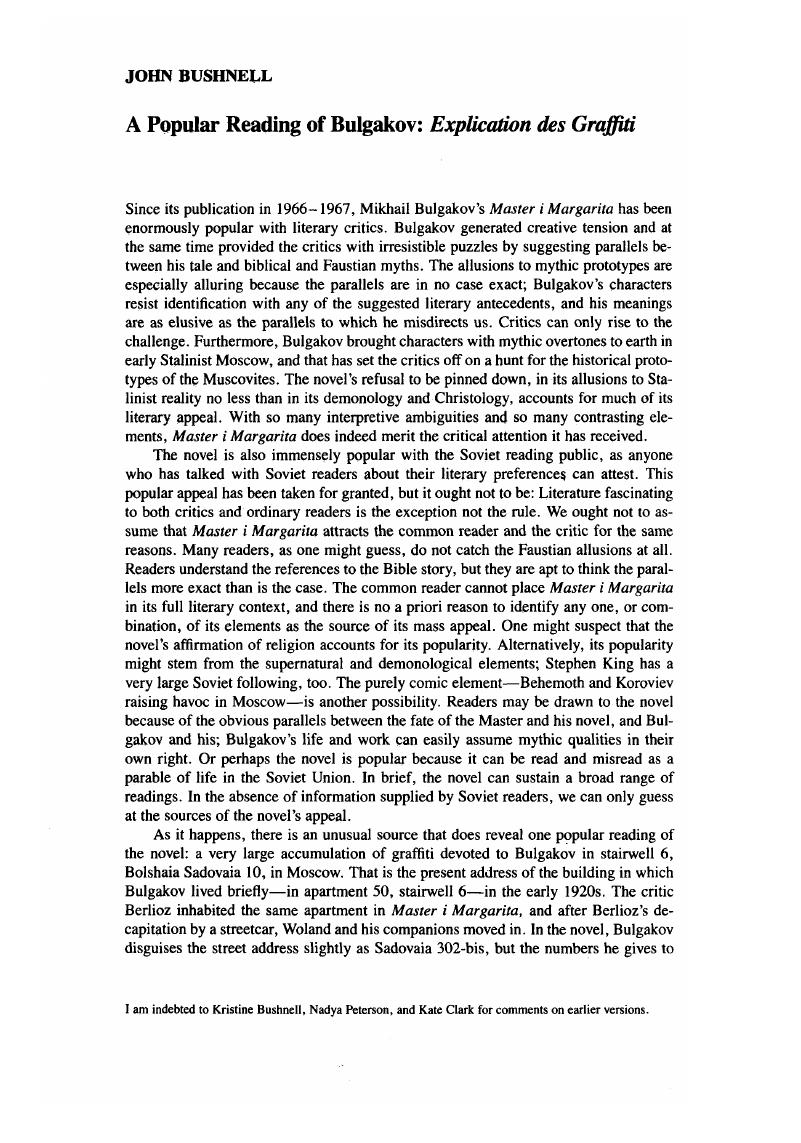Published online by Cambridge University Press: 27 January 2017

1. See Levshin, V., “Sadovaia 302-bis,” Teatr, no. 11 (1971), pp. 110–120 Google Scholar. Levshin deduces from the pattern of sunlight that falls in apartment 50 in the novel that the fictional apartment was not the real apartment 50, but an apartment (Levshin's as a boy) across the courtyard. If true, that is a subtlety lost on readers, who prefer to identify Berlioz's apartment with Bulgakov's and is yet one more instance of Bulgakov's use ofthe inexact referent.
2. The story of the collection from 1983 through June 1984 was provided by residents of the apartmentsin the stairwell. Tan, Aleksandr, “Moskva v romane M. Bulgakova,” Dekorativnoe iskusstvo SSSR, no. 2 (1987), p. 2 Google Scholar, claims to have found the stairwell chock full of graffiti in early 1983. That date is either misprinted or misremembered, because different residents questioned separately said they noticed no graffit iuntil the middle of 1983. The inscribed invitations that dated from late 1983 and early 1984 make no sense ifthe graffiti had been in full flower a year earlier. By 1987, however, a legend that admirers had been inscribingtributes to Bulgakov in the stairwell for decades was firmly established and was reported as fact by Thorn Shanker, “Midnight Mecca in Moscow,” Chicago Tribune, 11 January 1987. Some additional information about the graffiti can be gleaned from VI. Arsen'ev and Iu. Grin'ko, “ ‘Nekhoroshaia kvartira’ (Sadovaia, 302-bis, No. 50),” Izvestiia, 13 January 1985; Arsen'ev and Grin'ko, “'Museefitsirovanie netselesoobrazno.'Eshche raz o sud'be bulgakovskoi kvartiry,” Izvestiia, 7 January 1987; and Der Spiegel, 30 March1987, pp. 204, 207. For information on the collection as of mid-1985 and mid-1986 I am indebted to Michele Marrese and to Adele Barker of the University of Arizona.
3. Tan, “Moskva v romane M. Bulgakova “; Shanker, “Midnight Mecca “; Arsen'ev and Grin'ko, “Nekhoroshaia kvartira “; and “Museefitsirovanie netselesoobrazno,” Der Spiegel, 30 March 1987.
4. For the characteristics of modern Soviet graffiti, see John Bushnell, “Moscow Graffiti: Gangs, Argot, Subculture,” forthcoming in Semiotext (e).
5. For 1986, I draw on information and pictures provided by Adele Barker. Tan, “Moskva v romaneM. Bulgakova,” p. 28, lists the characters who appear on the walls, in descending order of frequency, as: Behemoth, Margarita on her broomstick, Koroviev, Pontius Pilate, Hella, and more rarely Woland, Azazello, and Jesus. That might possibly represent the state of the collection as of late 1986, but more likely Tanis guilty of imprecision. He claims the only inscription that is not a quotation from the novel is the frequently reiterated “Long Live Bulgakov “; that has never been the case. Tan also misdates the appearance of the collection (see note 2). His article is accompanied by a few pictures of the graffiti, including a drawing of Margarita on a broomstick. One suspects he has confused memorable visual impression with frequency count